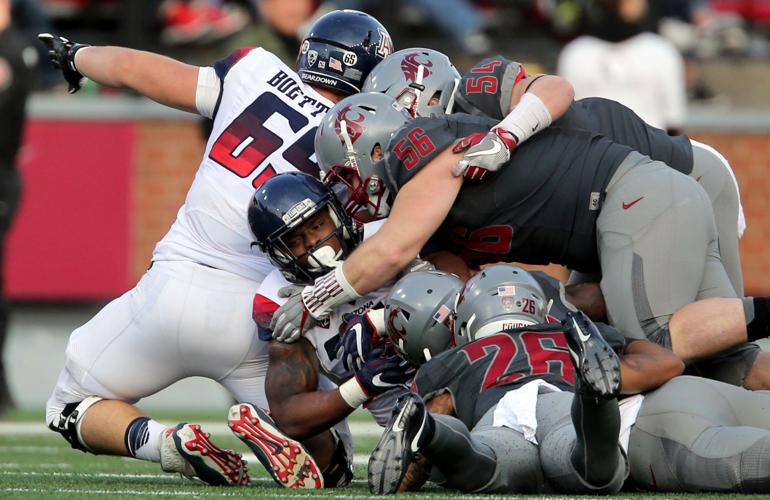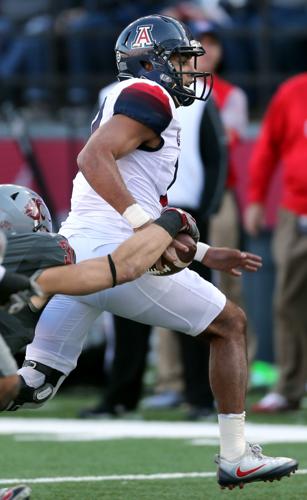The end of this disappointing Arizona Wildcats season is in sight. As such, it’s possible to reasonably project some of the offense’s final numbers.
It barely requires a calculator.
As things currently stand, Arizona is unlikely to have a 2,000-yard passer, a 1,000-yard rusher or a 1,000-yard receiver. The Wildcats had at least one of those — sometimes all three — in each of Rich Rodriguez’s first four seasons. The last time they had none of the above was 2006.
“I haven’t really looked at the numbers, but I don’t have to. I know it’s not good,” Rodriguez said Tuesday. “Some of it’s been interchangeable things at quarterback. It’s hard to get some continuity, probably. It’s frustrating because we have some talented guys. We’ve just got to get them in position where we make some more plays.”
The reasons for Arizona’s offensive slide have been covered ad nauseam: injuries at key spots, turnovers, poor field position, lack of execution, lack of player development. The raw numbers illustrate just how far the Wildcats have fallen.
Quarterback Brandon Dawkins leads Arizona in passing yards (1,058) and rushing yards (597). He would need to average 314 passing yards in the UA’s final three games, starting with Colorado on Saturday, to reach 2,000. His high for the season is 243.
To put that number in perspective, Anu Solomon passed for 283 yards in last year’s game vs. Colorado — and didn’t throw a pass in the fourth quarter, when Rodriguez replaced him with Jerrard Randall.
Dawkins is averaging 74.6 rushing yards per game. (He missed the Oct. 15 game against USC because of a concussion.) He would need to average almost double that — 134.3 — to reach 1,000. No one else has a realistic chance. Given that Rodriguez plans to continue to rotate his quarterbacks, Dawkins probably doesn’t, either.
Arizona’s leading receiver, sophomore Shun Brown, has 25 catches for 406 yards and three touchdowns. That puts him on pace for 33, 541 and four. (All projections are for 12 games. It should be noted that the UA played 13 games in 2012, ’13 and ’15, and 14 games in ’14.)
The lowest previous totals for a leading receiver under Rodriguez came via then-freshman Nate Phillips in 2013: 51 catches for 696 yards. Phillips had seven touchdowns. At least one receiver had at least six in each of Rodriguez’s first four seasons.
Stats aren’t a frequent topic of conversation among the wide receivers or any position group.
“I try not get caught up in the numbers because I tell the kids not to,” receivers coach Tony Dews said. “I tell them to focus on doing their individual job on each and every play in practice, and each and every play in the game, and let the other stuff come. If you’re doing your job and doing what you’re supposed to do and you’re playing at a certain level — the standard that’s been set by the head coach and the program — then I’m happy.”
As a team, Arizona is running its fewest plays (67.8 per game) and gaining its fewest yards (400.8) under Rodriguez. The previous lows: 76.2 plays per game in 2015 and 458.5 yards per game in ’13. Interestingly, the UA is averaging more yards per play (5.9) than in 2014 (5.7) or ’13 (5.8).
The Wildcats are averaging 22.2 points per game. That’s down more than 15 points from last season. Arizona’s lowest output in Rodriguez’s first four seasons was 33.5 in 2013.
“It’s shocking,” senior running back Samajie Grant said. “At least give me 30 every game. If that was the case, we’d have probably won half our games.”
Every player and coach would tell you they’d trade their individual numbers for victories. The two, alas, work hand in hand.
‘A feel thing’
Rodriguez said he doesn’t have a set plan yet for the quarterbacks against Colorado. Dawkins started the past two games, with Solomon entering in relief. Dawkins appeared to hurt his right hip or side late in the first half of last week’s game at Washington State.
“It’s going to be a feel thing,” Rodriguez said. “I couldn’t tell you who’s going to be the first one out there. It’s back and forth with Brandon and Anu.”
Dawkins “looked rusty” in those two games, Rodriguez said. Dawkins missed practice time last month because of a rib injury and the aforementioned concussion.
“That’s probably understandable,” Rodriguez said. “We’ve got to shake that off and just play better.”
Solomon received his most extensive playing time since Week 1 in the 69-7 loss to the Cougars. He offered this self-assessment:
“Watching the film, I felt like I was a little bit uncomfortable, a little bit antsy at times, and other times I just felt like I could’ve done better — the laterals, my fumble. But all in all, I did an all-right job. Got the rust off me. Hopefully I can do a better job this week.”
Extra points
- Guard Freddie Tagaloa started Saturday for the first time since Sept. 24. He had been bothered by a knee injury. “I played pretty well, played better than I did at the beginning of the season,” Tagaloa said. “As long as I keep progressing, I’m going to be happy with the way I’m playing. But overall, it really doesn’t matter if I do good if we lost 69-7.”
- Rodriguez on Arizona’s weekly field-position deficit: “The margin’s probably one of the worst in the country.” According to the website bcftoys.com, Arizona is tied for 126th in the nation — out of 128 teams — in net starting field position (10.3 yards worse than opponents’ cumulative starting field position).
- Rodriguez on trying to win vs. playing younger players: “The message to the team is that you’re trying every week to win. To be fair to the seniors and the program, you try all you can to win.”





